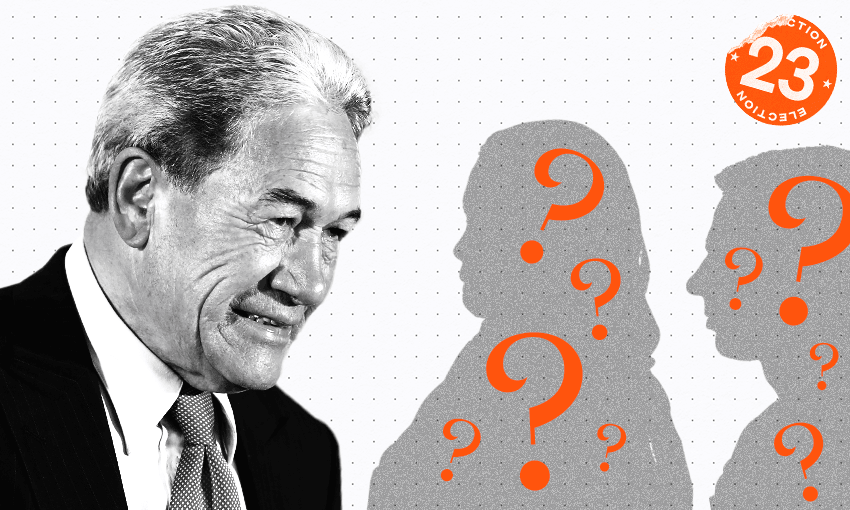NZ First’s team has some returning names from 2017-2020, alongside some fresh faces. So who makes up their caucus this time around?
Winston Peters’ New Zealand First bowed out of parliament in 2020 after achieving their worst-ever election result, receiving only 2.6% of the party vote. But after three years in the political wilderness, they’re back.. While it remains to be seen if they’ll form any part of a National-led government, NZ First will certainly have a presence in parliament – this year they boosted their party vote to 6.46%, which equates to eight seats.* Only four of NZ First’s 2017-2020 cohort of nine MPs have returned to Wellington, however. So, who are the old and new members of NZ First’s 2023 team heading to parliament?
*Pending special votes, which make up around 20% of the total and usually favour left-leaning parties, so aren’t expected to shift NZ First’s seat allocation too much.
Returning MPs
As Paddy Gower said, everyone knows who Winston Peters is. Shane Jones (#2 on the party list, Northland candidate) is almost equally well-known, so we’ll move right along.
Mark Patterson
- #4 on the party list
- Taieri candidate
Part of Peters’ 2017-2020 parliamentary team, Patterson runs beef and sheep farms in Otago with his wife and until recently was the Otago Federated Farmers chair. It makes sense then that Patterson has led the charge on the party’s agriculture policy. His knowledge in the agricultural space is based on what he calls “boots on the ground” knowledge, which he thinks is missing from parliament. The self-described patriot used to support National until they allowed the sale of Silver Fern Farms to Chinese buyers in 2016, after which he moved to NZ First.
Jenny Marcroft
- #5 on the party list
- Kaipara ki Mahurangi candidate
Despite resigning from the party following their 2020 election defeat – citing cultural issues like the lack of women – Jenny Marcroft is now back in NZ First’s caucus. Before she was a parliamentarian the first time around, Marcroft spent 30 years in radio and television. Following her first parliamentary stint, she worked in the health sector, briefly went back into media and most recently worked for Auckland mayor Wayne Brown. During her early broadcasting career in the 90s, Marcroft – a Ngāpuhi wahine – put great effort into including kupu Māori with correct pronunciation, which she was criticised for at the time.
New MPs
Casey Costello
- #3 on the party list
- Port Waikato candidate
A former detective sergeant in the police and vice president of the police union – the first female elected to such a position – Casey Costello has held senior positions in lobby groups. She is a founding trustee of Hobson’s Pledge and former chairperson and board member of the Taxpayers’ Union. Costello – who is of Anglo-Irish and Ngāpuhi/Ngāti Wai descent – has been an outspoken opponent of co-governance, with Peters saying her “willingness to defend our democracy has been uncompromising”. Outside of police and politics, Costello runs a foundation to support victims of migrant exploitation. She has also held managerial positions in the construction and security industries, even once overseeing parliamentary security.
Jamie Arbuckle
- #6 on the party list
- Kaikōura candidate
Jamie Arbuckle is one of the most experienced politicians in NZ First’s team, having spent 13 years as a Marlborough district councillor. At Marlborough Council, Arbuckle previously held RMA roles and, this term, chaired the economic, finance and community committee. He has also run three second-placed bids for the Marlborough mayoralty and contested two previous general elections for NZ First. Since 2020, Arbuckle has been a member of NZ First’s board, and even before being announced as the party’s Kaikōura candidate, he was heavily involved with their campaign. At 43 years old, Arbuckle has spent most of his adult life in politics.
Andy Foster
- #7 on the party list
- Mana candidate
Another local government stalwart, Andy Foster was a Wellington councillor from 1992-2019 before becoming a one-term mayor (2019-2022). As a self-described “bluegreen” – a rightwing environmentalist – Foster’s lasting legacy in Wellington comes not from his time as mayor but as a local representative. He was instrumental in the success of the Zealandia eco-sanctuary and other environmental initiatives. He continued shining bluegreen as mayor, funding the capital’s climate action plan. As mayor, he was also supportive of trans rights, putting him at odds with NZ First policies that seek to restrict trans freedoms. Before his council stints, Foster worked as a parliamentary researcher for the National Party, in investment finance and taught economics.
Tanya Unkovich
- #8 on the party list
- Epsom candidate
Tanya Unkovich has worn many hats – finance professional, public speaker, author, life and business coach – but the issue that motivated her to run for parliament was mental health. She is a trained counsellor. Unkovich has also been outspoken against Covid-19 restrictions, on her Twitter account criticising the restrictions that she said prevented her whānau from attending her father’s funeral and her brothers from being at their parents’ bedsides as they died. Earlier this month, Newshub confirmed that Unkovich is part of the “Nuremberg Trials” Telegram channel, which likened Covid-19 vaccines to Nazi war crimes.
This is Public Interest Journalism supported by NZ On Air.





